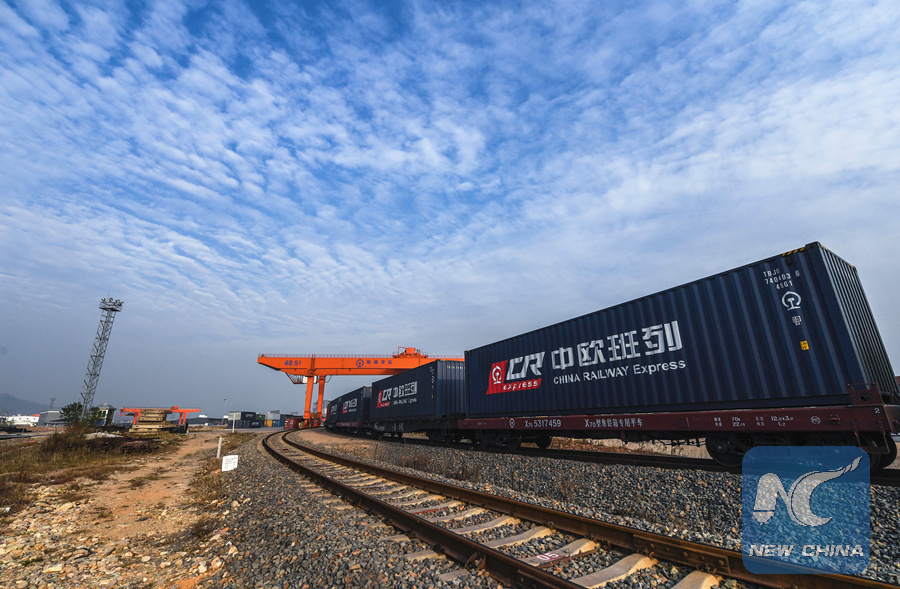BRI: Initial five years and the way ahead
- By Rachana Gupta
 0 Comment(s)
0 Comment(s) Print
Print E-mail China.org.cn, October 3, 2018
E-mail China.org.cn, October 3, 2018

The year 2018 marked the completion of the first five years of the Belt and Road Initiative (BRI). On this occasion, while addressing a conference at Beijing, President Xi Jinping shared his vision, and also highlighted the complex problems and risks involved.
He stressed the nature of the Initiative as an economic cooperation rather than any sort of geopolitical or military alliance, intended to create an open club promoting inclusiveness instead of being in any way an exclusive "China Club."
Xi also focused on the elements of making joint efforts in developing dialogue, economic integration and win-win cooperation by providing opportunities for the common development based on mutual trust.
The grand project was started with an historic speech of President Xi on China's Central Asia strategy at Nazarbayev University in Astana, Kazakhstan. There, he proposed – for the first time –the building of a "Silk Road Economic Belt."
Later in the same year, while addressing Indonesia's Parliament in Jakarta, he went further in his ambitions and proposed the building of the 21st Century Maritime Silk Road. The BRI ever-since has become a focal point of China's foreign policy with five core areas of infrastructure development, strengthening political cooperation, developing trade ties, financial integration and people-to-people exchanges.
Accomplishments in the last five years
In the last five years, many projects have been successfully completed, mainly funded by the Asian Infrastructure Investment Bank (AIIB), EXIM Bank and the China Development Bank. Some of the biggest, each worth over US$1 billion, are:
• Railway network constructions in Laos and Malaysia
• Seaport construction and modernization in Pakistan, Sri Lanka, Turkey and Israel
• Power plant construction in Vietnam, Pakistan, Russia, Indonesia, Laos, Nepal and Bangladesh
• Oil and gas pipe networks construction in Brunei, Myanmar, UAE, Pakistan, Russia, South Africa, Iraq and Kazakhstan
• Real estate projects in South Korea, Sri Lanka and Malaysia
• Logistics centers in Singapore
• Steel mill construction/purchase in Mongolia, India, and Serbia
• Financial sector investments in Singapore, South Korea, and the Czech Republic
In the past five years, China has poured almost $80 billion into non-financial sectors of the wider region to support the Initiative. It has set up 82 overseas economic and trade cooperation zones, creating about 244,000 local jobs.
Additionally, as of May 2018, it had signed 16 free trade agreements with 24 countries and regions, as well as new construction contracts worth $57.11 billion have been awarded along the Belt and Road.
To further boost integration through cultural and academic exchanges, China has set up 81 educational institutions and 35 cultural centers. In the first half of 2018 alone, it spent around $39.3 million on Silk Road scholarships.
Way ahead
Thus, it is evident that the BRI so far has been moving in a positive direction. Covering nearly two-thirds of the world's population, this mega initiative has already started opening doors of prosperity for more than 103 countries –across Asia, Europe and Africa.
In the past five years, China's trade – in goods – with countries involved in the BRI has already exceeded $5.5 trillion and still has massive growth potential with further investments in the pipeline.
The whole idea is to provide development opportunities not only to less developed regions by helping them to get rid of poverty but also to developed groups of countries through regional integration and creating new avenues for further progress.
In this regard, China, in the coming decades, plans to spend over $1 trillion on the projects falling under the BRI, focusing mainly on free trade zones, railways, ports, energy pipelines and grids to improve land and sea connectivity, and wide-ranging cooperation facilitating a free flow of goods, services, personnel, capital and information.
Additionally, the primary focus is more on projects that can generate real values to the local people, and bring social benefits. Hence, China will emphasize on developing balanced trade relations by substantially increasing import from countries along Belt and Road routes.
Moreover, it will cooperate with relevant countries in a number of fields: healthcare, education, culture and environment protection and help them in training more talent. Furthermore, it will extend its third party cooperation with developed countries. Currently, the Chinese and Japanese governments are working on details to cooperate on Thailand's Eastern Economic Corridor projects.
Although the initiative is big in ambition and may have some setbacks, its successful implementation will inject huge vitality in the world's economy.
Rachana Gupta is a China Focus columnist, an expert author of Ezine Articles and an active blogger and poetry writer.
Opinion articles reflect the views of their authors only, not necessarily those of China.org.cn.






Go to Forum >>0 Comment(s)